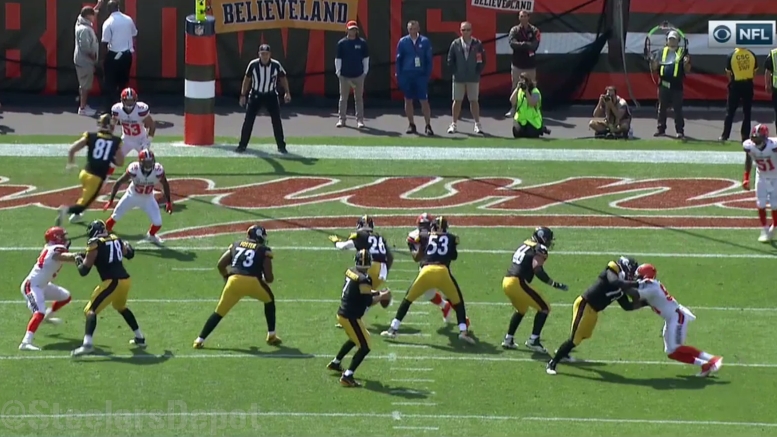The first game of the regular season has come and gone, and that can only mean one thing: the highly anticipated debut of our weekly charting notes kicking into full gear. This year, I’ve tried to incorporate some additional items to keep track of in my notes for the Pittsburgh Steelers on the offensive side of the ball. As we usually do, we will start with personnel packages.
- Personnel groupings:
- 01: 9/61 (14.8%)
- 11: 38/61 (62.3%)
- 12: 4/61 (6.6%)
- 21: 1/61 (1.6%)
- 22: 6/61 (9.8%)
- V-32: 3/61 (4.9%)
- So what can we draw from this? Evidently, the Steelers really, really like their wide receivers, because they had at least three of them on the field at the same time for over 80 percent of their meaningful snaps. If you remove the victory formation snaps, they ran out of 01 or 11 on 47 of 48 snaps, or 81 percent of their total.
- Conversely, there was not much usage of multiple-tight-end sets, though that is not too surprising considering the scarcity of running plays. Seven of their 10 snaps with multiple tight ends were designed runs.
- It is interesting to note that while Vance McDonald did not play a ton of snaps—18 to be exact—five of them came with him as the lone tight end on the field. He was also paired with Xavier Grimble for the latter’s lone snap. They were, however, incredibly unsuccessful on those plays, averaging -.33 yards per play when factoring in a hold by McDonald himself.
- As is probably obvious by now, Le’Veon Bell a light workload, seeing only 41 snaps in non-victory formation roles, and that includes a pre-snap penalty play. That accounts for nine snaps with four receivers on the field and eight snaps for James Conner.
- It was interesting to see that Antonio Brown got six meaningful snaps off during the game. All six came out of the 22 personnel, and on five of those snaps, JuJu Smith-Schuster was the lone receiver. Martavis Bryant was the receiver on the sixth snap. Predictably, all of them were runs—on two of which, Smith-Schuster was flagged for holding.
- Now on to the fun stuff. On three play-action passes, Ben Roethlisberger was three-for-three for 69 yards, averaging 23 yards per attempt. However, one 15-yard completion was negated by penalty, so officially he was two-for-two for 54 yards, averaging 27 yards per attempt.
- He was also blitzed heavily 15 times out of 40 dropbacks, and he did well, the Steelers averaging 11.4 yards per play, with penalties factored in. He threw only three incompletions, one of which was batted down at the line of scrimmage. Another was defended by the defensive back, and the third drew a 41-yard pass interference call. The Browns blitzed eight on the pass interference play.
- On 28 passing snaps, Bell stayed in to protect nine times. On one, he leaked out late as an emergency option and gained 10 yards.
- On 36 passing snaps, Jesse James only stayed in to block three times. Vance McDonald did so twice on seven passing snaps.
- The Steelers pulled Ramon Foster three times. David DeCastro also pulled three times—or would have, as one snap was a delay of game. Fosters’ pulls were on runs; DeCastro’s were on passes. Vance McDonald pulled once on a running play.
- Average depth of target – 7.3 (39 targets)
- Martavis Bryant – 12.6 (7 targets; 6 official)
- Eli Rogers – 5 (4 targets) [includes batted ball]
- Le’Veon Bell – -.8 (6 targets)
- Jesse James – 4.3 (8 targets)
- Antonio Brown – 11 (13 targets; 11 official)
- Vance McDonald – 5 (1 target)








